At first glance, Worldwake looks to be a set intended for Timmy and the Drafters. Many of the cards seem to fill needed holes in Zendikar limited, while others have loads of flavor and casual appeal. The set isn't loaded with Tier 1 powerhouse cards, but the EV of Worldwake might surprise you. Before I delve into the actual numbers, let's briefly recap what EV is and how we get to the number we use.
EV is short-hand for "Expected Value," and if you're a poker player, you'll immediately know what this means. It's a way of gauging investment versus return when you know, approximately, the stakes and the chance of all possible returns. While Magic and Poker games generate massively complex scenarios, the roll of a six-sided die provides a simple & elegant example. Let us say that we roll a fair d6, where our outcome set is [1,2,3,4,5,6]. We can agree that if it is in fact a fair d6, each outcome in the set is equally likely. There's no need to weight any given item in the set. We find the mean by adding 1+2+3+4+5+6 (21) and then dividing it by the number of members in the set, 6 thus: 21 / 6 = 3.5.
In this case, 3.5 is not among the possible outcomes, but let's turn the mean into EV. Say that you bet $3 per roll of the dice and were paid out $X, where X is the number shown on the die. Is this a good bet? Of course it is! If you roll a 1 or a 2, you lose $2 or $1, respectively. If you roll a 3, you essentially get to "mulligan" your roll. If you roll a 4 or a 5, you gain $1 or $2, and if you hit a 6, you double your investment. By correlating the payout to the odds, like many games of chance do, we can use EV to skip all of that verbiage and get right to the heart of the issue. If you repeat the experiment to infinity, your average iteration will yield $3.5 on an investment of $3.
This model does not factor in things like your stopping point or your bankroll size. Standard deviation is a topic best left to real mathematicians, be mindful of how many iterations you can reasonably perform within your budget. If you only have $3, then your EV is very low. While you can keep going 66% of the time, which in turn increases your EV, if you hit the 33% on the first roll, you must stop. Even by increasing your bankroll to $5, you ensure a second play, which cuts your chances of "going bust" dramatically. This is why poker players preach bankroll management. The term to know here is "variance." That is a fancy way of describing the phenomenon known as "getting screwed hard by the odds." It happens, and it should just be factored into your considerations.
Now that you're reconsidering that trip to Vegas over Spring Break, lets start applying this brainy stuff to Magic.
Magic cards come in booster packs, in which we can assume that there exists 1 rare, 3 uncommons and 10 commons. Some Worldwake packs had turned up missing rares, but the problem didn't seem widespread enough to really factor in. Over a large enough sample size, they should become statistically irrelevant. We first apply a bit of discretion to the cards we are opening; we immediately disregard common cards, because they have almost no individual value and have almost no secondary market value at all. The same is true for Uncommons, with the exception of those that are fetching a $1.50. In that case, it's Kor Firewalker and Tectonic Edge. We make note that there are uncommons to consider, and move on to the rares.
When looking at the rares in a set, a certain amount of judgment needs to be used. The secondary market value of "crap rares" is often lower than the "book" value of them, so we zero them out. Despite that Terra Eternal is worth $0.75, the chances are that we can't ever sell it or trade it for that price. Thus, we simply act as if it exists as a zero in our set. Worldwake only has a handful of rares that are worth any significant sum ($4 or more). We mark those on our spreadsheet and move on to Mythic Rares.
We see that Mythics are much better per card than rares in Worldwake. There are 9 rares in the set worth their paper, and 6 mythics that are $5 or above. I raise the bar slightly higher for Mythics, since many of the mediocre Mythics still command a $4 dealer price despite being nigh untradeable. You can make your own lists of cards if you wish to change the criteria, but this has worked nicely for me in the past with M10 and Zendikar.
Once you generate your list of cards and prices, separated by rarity, simply find the mean of each rarity's dollar value, as described in the d6 example above. There are 35 Rares and 10 Mythic Rares in Worldwake, so add up all the dollar values of the rares and divide by 35. Remember, the other rares in the set have been zeroed out, so they still count as a possible outcome. If you want to be more generous, you can set rares below your threshold to $0.25 to represent the fact that you might get some small value out of them. Do the same for Mythic Rares. Feel free to set the zeroes to $0.50 if you must.
Now we have to deviate from the d6 example above. Mythic Rares add another computation to our formula. Luckily, it's an easy one. The stated odds of getting a Mythic Rare are 1 in every 8 packs, which means the odds of getting a regular rare are 7 in 8. Thus, we multiply the mean value of our Rares by 0.875 (7/8 in decimal) and the mean value of our Mythics by 0.125 (1/8 in decimal). That weights the two rarities correctly. In my case, I found that the unweighted value of a Rare was $1.57 and a staggering Mythic value of $12.25. I think we know who to blame for those ridiculous numbers. Weighting them appropriately and adding them together brings you to $2.90.
If you'd like to factor in the Uncommons, it's easy to do so. There are 40 in Worldwake, of which only two are truly relevant. Assuming all others are zero value, the mean value of Uncommons is $0.075, (1.5 + 1.5) / 40. Since we get three to a pack, we multiply by 3 (just as we multiplied by .125 with the Mythic Rares), which brings us to $0.225 per pack. Here, it's okay to round up to $0.23. Because the Uncommon distribution has nothing to do with the Rare or Mythic distribution, we simply add $0.23 to $2.90 to get $3.13, and there's our EV!
Actually, calling that number EV is a bit misleading. That's your mean value, weighted, per pack, and it doesn't take into account foils or the bulk price of commons and uncommons (which is roughly $4 per thousand, so it doesn't really change your EV). Your EV can only be derived once you have a cost per pack. CoolStuffInc.com can ship you a box of Worldwake for about $90 after all associated costs, which amounts to $2.50 per pack. Thus, your true "EV" on a box of WWK from CoolStuffInc is a cool +$0.63 a pack! Killer!
Comparing Worldwake to previous sets, I'm a bit disappointed. The EV of Zendikar was ridiculous because of fetch lands and M10 was high because of a lot of expensive cards. Both had mean pack values approaching the $4 mark, which was almost unheard of pre-M10. Worldwake probably has some room to grow, since the Pro Tour is right around the corner. New tech will almost assuredly emerge, and with it, values will certainly change. Because so much value is concentrated in two Mythic rares, the variance of the set is much higher than average. In fact, if you remove Jace and Abyssal Persecutor and zero them out, your mean pack value drops to $2.00 even. With a rate of about 4-5 Mythics per box, you can easily miss both Jace and Persecutor in a single box, and there's no guarantee you'll get either as you continue opening boxes. Without knowing much about the print runs, it seems safe to say that if you're opening Worldwake to fill out sets and a trade binder, open at least 3 boxes.
Having sold multiple cases to local players myself, I can say that the best way to open Worldwake is to find someone with whom you can split a 6-box booster case and agree in advance to split the cards, not the boxes. I saw a pair of guys split a case. One opened all the Jaces, one opened all the Persecutors. There was much animosity. Thus, I suggest that you split a case with a trusted friend and basically Rochester Draft the rares to keep. Not common, but a good way to minimize variance and keep everyone happy.
That's it for now! Hopefully the prerelease and release weekends didn't burn you out too badly, since we have a brand new Standard format to play this week at FNM! I've been grinding out new decks, but nothing has yet convinced me to stop playing Jund. I will say this, however: Grixis can see an awful lot of cards by using Ponder, Halimar Depths and Treasure Hunt. What you do with that information is up to you, but I may just tune up my list and play it at my store's Standard tournament this evening.
Talk to you next week, Magic fans!



























